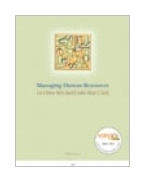For undergraduate or graduate level Introduction to Human Resource Management courses.
This book covers all of the core HR topics, while taking a “non-functional” approach
that shows the relevance of HR topics to all employees.
Table of Contents
Introduction
1. Meeting Present and Emerging Strategic Human Resource Challenges
Part II. The Contexts of Human Resource Management
2. Managing Work Flows and Conducting Job Analysis
3. Understanding Equal Opportunity and the Legal Environment
4. Managing Diversity
Part III. Staffing
5. Recruiting and Selecting Employees
6. Managing Employee Separations, Downsizing, and Outplacement
Part IV. Employee Development
7. Appraising and Managing Performance
8. Training the Workforce
9. Developing Careers
Part V. Compensation
10. Managing Compensation
11. Rewarding Performance
12. Designing and Administering Benefits
Part VI. Governance
13. Developing Employee Relations
14. Respecting Employee Rights and Managing Discipline
15. Working with Organized Labor
16. Managing Workplace Safety and Health
17. International HRM Challenge
Features
For undergraduate or graduate level Introduction to Human Resource Management
courses.
This book covers all of the core HR topics, but takes a “non-functional” approach that
shows the relevance of HR topics to all employees.
Q. How do you show your students the relevance of HR topics to non HR professionals?
Manager’s Notebook: This feature examines HR issues that managers regularly deal with.
It is divided into 4 categories.
· Customer-Driven HR- discusses treating employees as internal customers (ex. Pg 53).
· Ethics- examines the HR related ethical issues that managers and employees regularly
face (ex. Pg 17).
· Emerging Trends- looks at the latest developments in the HR field (ex. Pg. 71).
· Global- looks at how HR practices and policies from around the world can affect the
global marketplace in the U.S. (ex. Pg 19).
Q. How do you help your students understand HR theory with limited work experience?
“You Manage It!” Discussion Cases- each section in the Manager’s Notebook is
accompanied by an author-developed case study, which includes critical thinking questions,
team exercises, and experiential exercises. (ex. Pg. 40)
Other Key Points of Differentiation
Q. How do you cover outsourcing as an HR topic?
NEW! Discussion of outsourcing to India and China have been added to Chapter 2 (pg. 70).
Coverage on outsourcing has also been added to Chapter 17 “International HRM Challenge”
(pg. 549).
Q. What topics do you cover in your course in regards to diversity?
NEW! Addressing religious diversity has been added to the diversity coverage in Chapter 4
(pg. 132)
Q. How do you address the effect of technology in the training and development of
employees?
NEW! Chapter 8 now looks a how online technology is being used to train employees in areas
such as ethics and increasing team performance. It also examines its effectiveness in the
area. (pg. 249)
Q. How has your coverage of ethics changed in the wake of the Sarbanes-Oxley Act?
NEW! Chapter 11 addresses the implications of Sarbanes-Oxley in regards to rewarding
employee performance (ex. Pg. 360). Also, Chapter 14 examines the legal protection now
provided to “whistle-blowers” (pg. 449)
Hardback
616 pages


